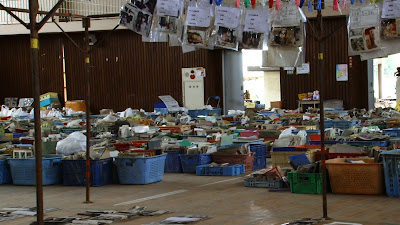18.05.11 (Fri)
On the way to Sendai from northern Ibaraki, the mountains are so clearly seen and so green and beautiful. But there are much fewer cars than there usually is …its kind of sad….北茨城から仙台に移動中です。山のみどり色が鮮やかです。しかし車の通行量が異常に少ない。さみしい。
5月18日
20.05.11 (Fri)
Today in Ishinomaki, we got sent to a house near the station. The house looked like nothing had changed after it had been hit two months ago by the tsunami. It looked as if it would be completely destroyed if another earthquake were to happen.今日は石巻に行きました。私たちが派遣されたのは駅前商店街の一歩裏手のお宅でした。そこは津波が来てから二ヶ月間そのまんま、という印象の、もう一度大きな余震が来たら全壊してしまうんじゃないかと思うようなお家でした。
5月20日
20.05.11 (Fri)
After volunteering for the day, we went to see the area of Minamihama-cho, which was one of the most damaged areas in Ishinomaki. Lots of thing had been washed away and where the city once stood is now just a big flat area. In the front of this area there is a big sign that says ”Ganbaro (Don’t give up) Ishinomaki” and many koinobori (fish shaped flags for Children’s Day on May 5th). Many people came here after work, and brought flowers and prayed.ボランティアに行った後、南浜町に行きました。南浜町は石巻の中でも被害が大きかった地区で す。たくさんのものが流され、広く見渡せるようになった街の入 り口に、「がんばろう石巻」と書かれた大きな看板と鯉のぼりがありました。仕事を終えた方々がそこに集まり、花を供え、手を合わせていました。
5月20日
20.05.11 (Frit)
Because the first floor was flooded, there was no flooring or tatami and the walls were totally destroyed. But an old lady with a cane (the house owner) was living there. When we offered to help her throw away her stuff (which was muddy and probably can’t be used any more), she didn't let us…every single thing is important for her even if it’s covered with mud… お家は一階部分が浸水し、床は抜けているしたたみも壁もぼろぼろでした。でも、そこで杖をつ くおばあちゃんが一人で暮らされていました。私たちが、水に浸 かってしまってもう使えないものを捨てましょうかと提案すると、おばあちゃんは、それは嫌だと首を振りました。泥だらけでも、どれも大切なもの。
5月20日
20.05.11 (Fri)
We covered the holes in the doors and the windows and cleaned her shoes and dishes. She thanked us many times but I’m worried about her living in the broken house alone…I just hope she wont get hurt herself..私たちは穴の開いてしまった扉や窓をふさいだり、おばあちゃんの靴を磨いたり、お皿を洗った りしました。おばあちゃんはありがとうとたくさん言ってくれた けど、あの壊れそうなお家で一人で暮らし続けると思うと、とても心配。どうか、怪我をなさらないようにと思うばかりです。
5月20日
20.05.11 (Fri)
Minamihama is very quiet…it seemed like nothing had changed since after the tsunami hit if you looked to one side of the street. However, if you looked at the other side of the street, it looked like they had cleaned up a lot of the debris. One lady told me with a smile, “Now we can start rebuilding!” She looked much happier than she had one month ago.南浜町はとても静かで、津波があったときからあまり変わっていないのではと思いました。でも そこから道路を挟んだ内陸側では瓦礫の撤去もかなり進んでいま した。お家の前の瓦礫が撤去された方は「復興が始まったのよ」と笑顔で話してくれました。一ヶ月前にお会いしたときとはまるで違う表情でした。
5月20日
20.05.11 (Fri)
Depending on the person, or even just a short distance, the differences encountered and the situations seen can be completely different. When will they be able to move on? What is it that they hold important? These are big questions that people must face, and answer differently. Some say, “We are going to rebuild. We will try move on.” with a smile, but some are filled with fear and depression.
数十メートルの差で、ひとりひとりそれぞれで、状況がまったく違います。動き出すタイミングも、大切なものも、まったく違います。もう復興するの、頑張るよと笑顔を見せてくれる人もいて、不安でいっぱいなひともいます。
5月20日
21.05.11 (Fri)
Today we went to Misawa port in Aomori. Misawa port (the first time for me to visit) was just sandy, empty land. I asked a man who was fishing there if the port had always been this way. He told me there had been several small shacks in this area and after the tsunami; the American military had come and quickly cleaned everything up.
今日はまず青森県三沢港まで行きました。初めて訪れた三沢港にはがらんと砂地が広がっていま した。釣りに来ていたおじちゃんに、前から空き地だったのかと 尋ねると、ここはたくさん小屋が建っていたんだとのこと。津波で壊れたものを、アメリカ軍がものすごい早さで片づけていってくれたんだよ。
5月21日
21.05.11 (Sat)
It is getting difficult to see the disaster that the tsunami had caused now that everything is slowly being cleaned up. The fact that we see less and less debris gives us hope and fills us with happiness, but at the same time we worry that people will forget all that has happened in the past 70 days.津波があったことが、目に見えなくなってきている。目に見えなくなることで生まれる明るいきざしと、記憶に残すことのむずかしさが同時に見えてきているように思いました。二か月と10日間の時間で起きたことたち
5月21日
21.05.11 (Sat)
I don't want to forget the things we have seen, even though it will be difficult to keep them fresh in our memories. We have to keep these memories…never to forget them and find a way to remember them. I believe that this is our job as we are artists and it should shape what we create and how it will influence our culture. とても難しいかもしれないけれど、忘れてはいけないものを忘れたくないと思います。忘れないように残すこと、またそこにアクセスする回路を作ることをしなくてはならない。それがきっと、文化にかかわる人の仕事だと思う。
5月21日
23.05.11 (Mon)
Today we are in Rikuzentakata, helping to clean up the debris on an apple farm. There were supposed to be 30 volunteers, but only 10 are working because there is a shortage of available workers. Although we could only complete half of what we had planned, the old lady who owned the farm thanked us and said, “Please promise me that you will visit us again”. She stood outside and watched our car leave, and stayed there until we could no longer see each other.今日は陸前高田にいました。りんご畑の瓦礫撤去のお手伝い。30人でやりたいところですが、人手不足で10人で作業。予定の半分しか片付かなかったのにおばあちゃんは、ありがとう、また来てね、約束よ、きっとよ。と私達の車が見えなくなるまでずっと見送ってくれました。
5月23日
24.05.11 (Tue)
There were many, many things broken and in disarray on the apple farm: cups, dishes, shelves, a car, comic books, seasonings, shoes, snacks, pictures, post cards, papers, magazines, trees, bikes, boats, containers, autographed balls, pots, building pieces, barrels, fish, sweaters, swimsuits, school bags, a laundry machine, key chains, cards, wallets, stuffed animals, bags, glass, mirrors, art materials...り んご畑には色んなものが落ちていました。お茶碗、食器棚、車、まんが、調味、靴、お菓子、 写真、ハガキ、書類、エロ本、流木、自転車、船、倉庫、椅子、 サインボール、鍋、建材、樽、魚、セーター、水着、ランドセル、洗濯機、キーホルダー、カード、財布、ぬいぐるみ、カバン、ガラス、鏡、画材、、
5月24日
24.05.11 (Tue)
Minamihama-cho, the area that had received the most damage in Ishinomaki, had first been further developed (for the small area it used to be) only about 40 years ago. The whole area that had taken two generations to build had disappeared in just a few hours.石巻のなかで被害の大きかった南浜町は、40年程前から開発が始まったエリアだったそう。二代かけて作った新しい町が、ほんの数時間で消えてしまった。
5月24日
24.05.11 (Tue)
and the old area of Minamihama, that had been around since the Meiji period, had also been washed away.そして、明治からある古い町も一緒に流されてしまったそうです。
5月24日
Translated by Akiko Tada /Robert Staehlin / Yuko Sakajiri


































